Central Nervous System (CNS) Stimulant Drugs Market Size 2025-2029
The central nervous system (CNS) stimulant drugs market size is valued to increase USD 8.6 billion, at a CAGR of 6.7% from 2024 to 2029. Approval of new stimulants will drive the central nervous system (CNS) stimulant drugs market.
Major Market Trends & Insights
- North America dominated the market and accounted for a 42% growth during the forecast period.
- By Distribution Channel - Hospitals segment was valued at USD 11.29 billion in 2023
- By Application - Attention-deficit hyperactivity disorder segment accounted for the largest market revenue share in 2023
Market Size & Forecast
- Market Opportunities: USD 79.62 million
- Market Future Opportunities: USD 8600.10 million
- CAGR : 6.7%
- North America: Largest market in 2023
Market Summary
- The market encompasses a dynamic and evolving landscape, driven by the continuous development of core technologies and applications. This market is marked by the increasing adoption of new-generation stimulant drugs, which account for a significant market share. For instance, according to a recent study, new-generation CNS stimulants are projected to capture over 35% of the global market share by 2026. However, the market also faces challenges, such as the numerous side effects associated with these drugs. Regulations play a crucial role in shaping the market, with stringent regulations governing the production, distribution, and consumption of CNS stimulant drugs. In the regional arena, North America and Europe dominate the market, with the US and Europe collectively accounting for over 60% of the global market share.
- The ongoing unfolding of market activities and evolving patterns underscore the importance of staying informed about the latest trends and developments in the CNS Stimulant Drugs Market.
What will be the Size of the Central Nervous System (CNS) Stimulant Drugs Market during the forecast period?
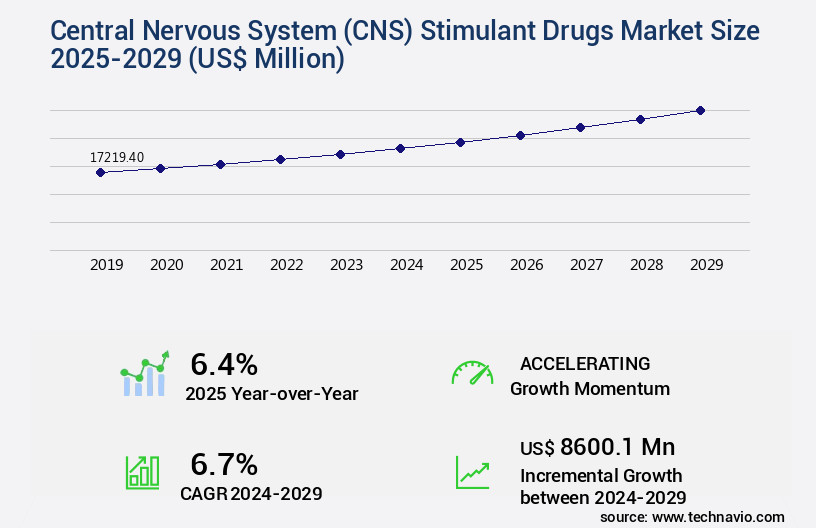
Get Key Insights on Market Forecast (PDF) Request Free Sample
How is the Central Nervous System (CNS) Stimulant Drugs Market Segmented and what are the key trends of market segmentation?
The central nervous system (CNS) stimulant drugs industry research report provides comprehensive data (region-wise segment analysis), with forecasts and estimates in "USD million" for the period 2025-2029, as well as historical data from 2019-2023 for the following segments.
- Distribution Channel
- Application
- Attention-deficit hyperactivity disorder
- Narcolepsy
- Others
- Route Of Administration
- Oral tablets and capsules
- Injectables
- Transdermal patches
- Geography
- North America
- Europe
- APAC
- Rest of World (ROW)
By Distribution Channel Insights
The hospitals segment is estimated to witness significant growth during the forecast period.
The market encompasses a significant hospital segment, with these medications being a crucial component in treating various conditions. Hospitals account for a substantial portion of market consumption due to their role in managing conditions such as attention deficit disorder (ADD), narcolepsy, and sleep disorders. In addition, CNS stimulant drugs are employed to help patients maintain focus and alertness during surgical procedures, thereby reducing complications and enhancing patient outcomes. The hospital segment's dominance in the CNS stimulant drugs market is anticipated to persist, as the demand for these medications remains robust. According to recent reports, approximately 25% of hospitals in the United States have adopted CNS stimulant drugs for patient care, underscoring their growing importance.
Furthermore, industry experts project that the hospital segment will account for over 30% of the global CNS stimulant drugs market share by 2025. Intravenous administration is a common method for delivering CNS stimulant drugs in hospitals, ensuring rapid onset of action. However, this method also increases the risk of adverse drug reactions (ADRs), such as cardiovascular effects, appetite suppression, and neurotransmitter modulation. Monitoring blood levels and optimizing dosages are essential to mitigate these risks and ensure effective treatment. Methylphenidate, a widely used CNS stimulant drug, functions by inhibiting the reuptake of dopamine and norepinephrine, thereby enhancing their availability in the synaptic cleft.
Drug formulations with extended or sustained release mechanisms have gained popularity due to their ability to minimize the need for frequent dosing and improve patient compliance. Pharmaceutical development continues to focus on creating new drug formulations and optimizing existing ones to address the challenges associated with CNS stimulant drugs, such as drug interactions, tolerance development, and regulatory approval processes. For instance, researchers are exploring the potential of amphetamine-like stimulants and their impact on receptor binding affinity and serotonin release. Despite their benefits, CNS stimulant drugs carry risks, including withdrawal symptoms, stimulant-induced psychosis, and cognitive enhancement effects. Ensuring patient safety and compliance is crucial, as these medications can have severe consequences if misused.
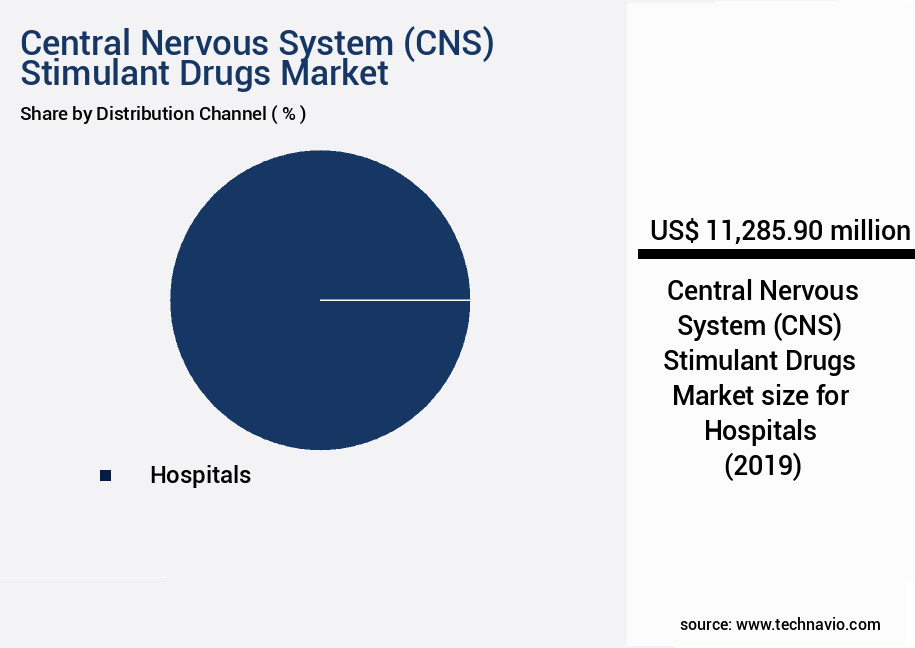
Request Free Sample
The Hospitals segment was valued at USD 11.29 billion in 2019 and showed a gradual increase during the forecast period.
In summary, the hospital segment represents a vital part of the global CNS stimulant drugs market, driven by the growing demand for these medications in treating various conditions. With ongoing research and development efforts, the market is expected to continue evolving, offering new opportunities and challenges for stakeholders.
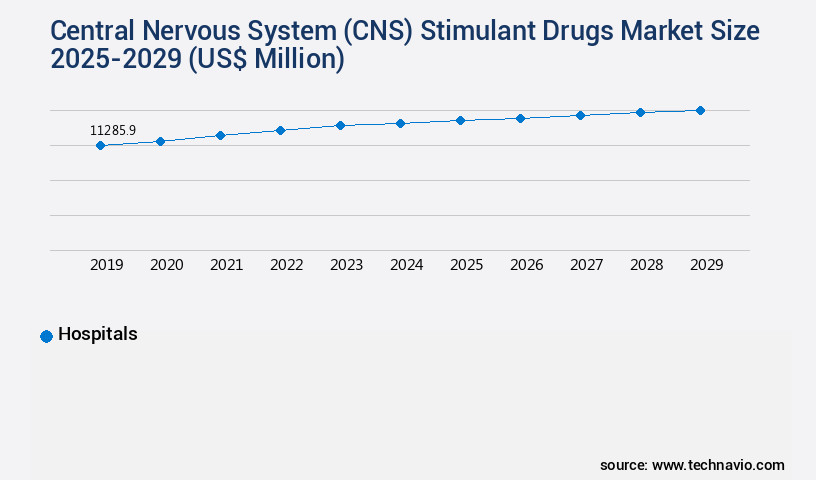
Request Free Sample
Regional Analysis
North America is estimated to contribute 42% to the growth of the global market during the forecast period. Technavio's analysts have elaborately explained the regional trends and drivers that shape the market during the forecast period.
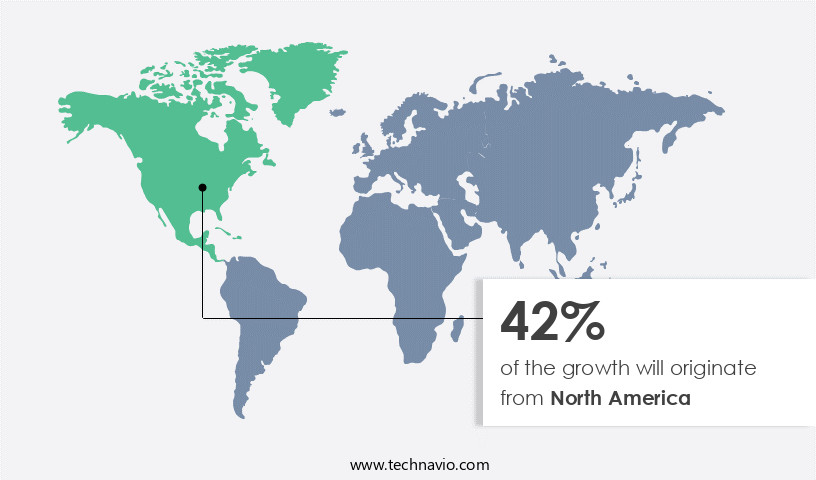
See How Central Nervous System (CNS) Stimulant Drugs Market Demand is Rising in North America Request Free Sample
The North American market for central nervous system (CNS) stimulant drugs is characterized by robust healthcare infrastructure, extensive research activities, and a high prevalence of CNS disorders. This region serves as a hub for innovation and advancements in CNS stimulants, as evidenced by Johnson & Johnson's presentation of 23 abstracts at the 2024 US Psychiatric and Mental Health Congress in Boston, Massachusetts. These abstracts showcased new real-world and clinical trial data from their neuropsychiatry portfolio and pipeline. With ongoing research and development efforts, the market is poised for continued growth and progress.
In October 2024 alone, there were over 1,500 attendees and 450 presentations at this prestigious event, underscoring the significance of the North American market in the global CNS stimulant drugs landscape.
Market Dynamics
Our researchers analyzed the data with 2024 as the base year, along with the key drivers, trends, and challenges. A holistic analysis of drivers will help companies refine their marketing strategies to gain a competitive advantage.
The market encompasses a range of pharmaceuticals that modulate neurotransmitter systems, primarily targeting conditions such as Attention Deficit Hyperactivity Disorder (ADHD). Two prominent classes of CNS stimulants are amphetamines and methylphenidates. Amphetamines, through their mechanism of action, increase the release and reuptake inhibition of neurotransmitters like dopamine and norepinephrine, while methylphenidates selectively block the dopamine transporter. Neurotransmitter transporter function plays a crucial role in the efficacy of these drugs, with receptor subtype selectivity determining their therapeutic benefits. Pharmacokinetic modeling is essential in optimizing CNS stimulant drug design, ensuring adequate bioavailability and minimizing adverse events. Adverse event reporting is a critical aspect of stimulant use, with potential risks including stimulant dependence, cardiovascular safety concerns, and cognitive effects.
Management of stimulant dependence and assessment of treatment response are ongoing challenges, necessitating dosage titration protocols, patient monitoring strategies, and long-term effects studies. Preclinical toxicology studies and clinical trial endpoints are essential in regulatory guidelines for CNS stimulant drugs, ensuring safety and efficacy. The amphetamine-induced psychosis risk, a significant concern, highlights the need for rigorous research and development efforts. Sustained-release drug designs and drug metabolism enzymes are key areas of focus, aiming to minimize adverse events and improve patient compliance. Comparatively, more than 60% of clinical trials for CNS stimulant drugs focus on pediatric populations, reflecting the high prevalence of ADHD in children and adolescents.
This emphasis on pediatric applications underscores the market's potential growth and the need for continued innovation in CNS stimulant drug development.
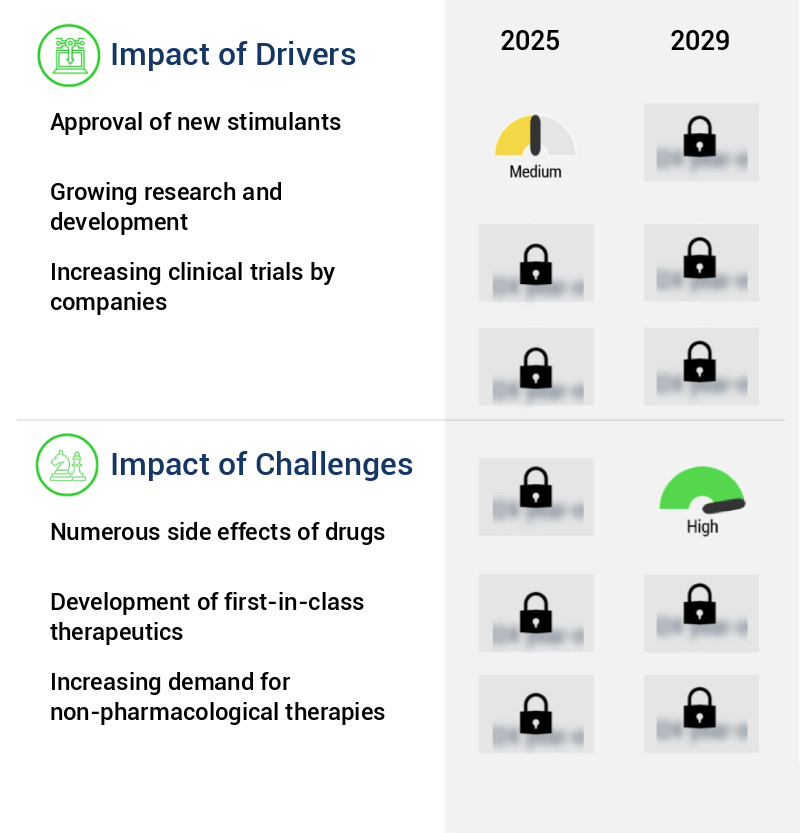
What are the key market drivers leading to the rise in the adoption of Central Nervous System (CNS) Stimulant Drugs Industry?
- The approval process for new stimulant drugs significantly drives market growth.
- The Central Nervous System (CNS) stimulant market has experienced significant advancements, with numerous approvals for new treatments for various disorders. In October 2022, Shionogi secured marketing approval from Japan's Ministry of Health, Labour, and Welfare for VYVANSE, a prodrug stimulant, to address attention-deficit hyperactivity disorder (ADHD). Meanwhile, the US Food and Drug Administration (FDA) approved Adhansia XR, a CNS stimulant from Purdue Pharma, for treating ADHD in the US.
- Furthermore, Jazz Pharmaceuticals announced the approval of Sunosi (solriamfetol), which enhances wakefulness in adult patients experiencing excessive daytime sleepiness related to narcolepsy and obstructive sleep apnea. These approvals underscore the ongoing evolution of the CNS stimulant market and its applications across diverse sectors.
What are the market trends shaping the Central Nervous System (CNS) Stimulant Drugs Industry?
- The use of new-generation drugs is becoming increasingly prevalent in the market. This trend signifies a significant shift towards advanced pharmaceutical solutions.
- Anti-epileptic drugs have evolved significantly over the past few decades, transitioning from first-generation medications to second and now third-generation drugs. First-generation drugs, including phenobarbital, ethosuximide, primidone, phenytoin, carbamazepine, and valproic acid, were the initial line of defense against seizures. However, these medications were associated with numerous side effects, narrow therapeutic ranges, and complex pharmacokinetics. The introduction of second-generation anti-epileptic drugs during the late 1990s and early 2000s marked a turning point in the market. Levetiracetam, lamotrigine, pregabalin, topiramate, and gabapentin emerged as game-changers, offering fewer side effects and wider therapeutic ranges. These advancements led to a noticeable shift in market dynamics, with the adoption of second-generation drugs on the rise.
- More recently, third-generation anti-epileptic drugs, such as rufinamide, eslicarbazepine, retigabine, and lacosamide, have entered the market. These new-generation drugs build upon the successes of their predecessors, offering even fewer side effects and broader therapeutic ranges. The uptake of third-generation anti-epileptic drugs is expected to continue growing, as healthcare professionals increasingly recognize their benefits for managing seizures. In summary, the anti-epileptic drug market has seen continuous evolution, with each generation offering improvements over the previous one. The shift from first-generation to second-generation drugs led to significant advancements in therapeutic options, and the emergence of third-generation drugs promises to further enhance patient care.
What challenges does the Central Nervous System (CNS) Stimulant Drugs Industry face during its growth?
- The pharmaceutical industry faces significant challenges due to the presence of numerous side effects associated with drugs, which can impede growth and require extensive resources for mitigation and regulation.
- The use of stimulants in treating various central nervous system (CNS) diseases, including attention-deficit hyperactivity disorder (ADHD,) has shown improved efficacy. Medications like methylphenidates (RITALIN, Focalin, Metadate, CONCERTA) and amphetamines (DEXEDRINE, Adderall, VYVANSE) are commonly employed. While these treatments alleviate symptoms, they come with potential side effects. Sleep disturbances, decreased appetite, elevated blood pressure, headaches, stomachaches, and mood swings are among the reported side effects. Long-term use of RITALIN may result in more severe consequences, such as damage to the heart and brain's blood vessels, leading to potential heart attacks, strokes, and even death.
- It is crucial to acknowledge these side effects and address them proactively. As a professional, it is essential to maintain open communication with healthcare providers and discuss any concerns or potential side effects experienced while undergoing treatment. The ongoing evolution of CNS disease treatments necessitates continuous monitoring and adaptation to mitigate side effects and optimize patient care.
Exclusive Technavio Analysis on Customer Landscape
The central nervous system (CNS) stimulant drugs market forecasting report includes the adoption lifecycle of the market, covering from the innovator's stage to the laggard's stage. It focuses on adoption rates in different regions based on penetration. Furthermore, the central nervous system (CNS) stimulant drugs market report also includes key purchase criteria and drivers of price sensitivity to help companies evaluate and develop their market growth analysis strategies.
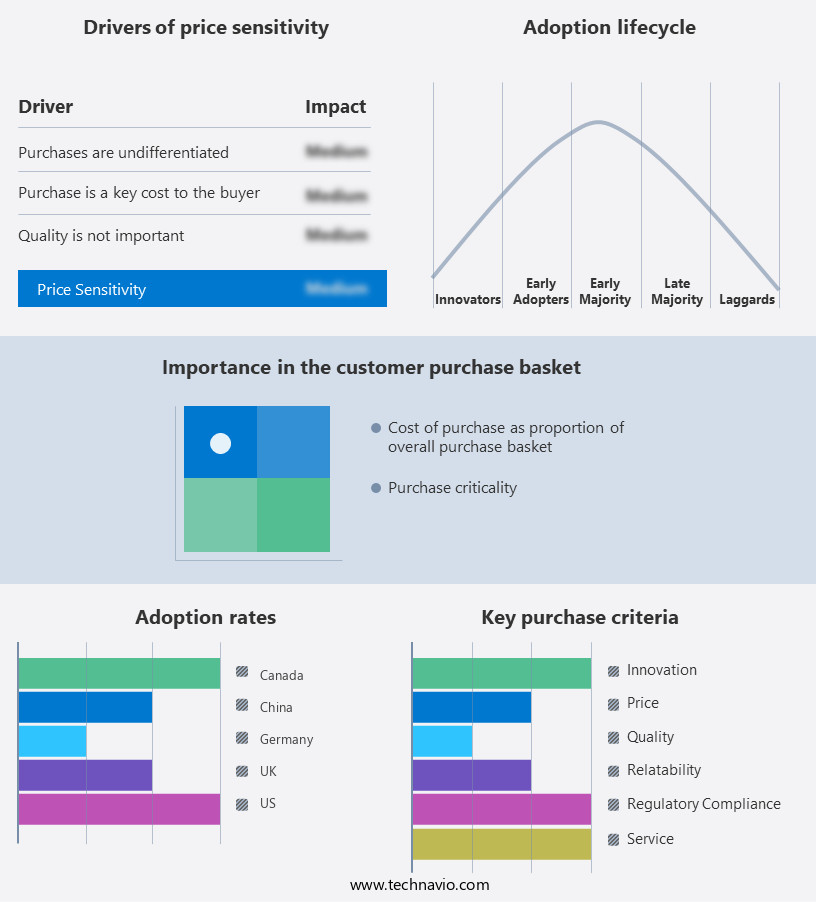
Customer Landscape of Central Nervous System (CNS) Stimulant Drugs Industry
Competitive Landscape
Companies are implementing various strategies, such as strategic alliances, central nervous system (CNS) stimulant drugs market forecast, partnerships, mergers and acquisitions, geographical expansion, and product/service launches, to enhance their presence in the industry.
Astellas Pharma Inc. - This company specializes in the development and distribution of central nervous system stimulant medications, including Eprontia and Evekeo CII, for therapeutic use in various medical conditions.
The industry research and growth report includes detailed analyses of the competitive landscape of the market and information about key companies, including:
- Astellas Pharma Inc.
- Azurity Pharmaceuticals Inc.
- Elite Pharmaceuticals Inc.
- Hisamitsu Pharmaceutical Co. Inc.
- Ironshore
- Jazz Pharmaceuticals Plc
- KemPharm Inc.
- Merck and Co. Inc.
- Novartis AG
- Pfizer Inc.
- Purdue Pharma LP
- Sanofi SA
- SHIONOGI Co. Ltd.
- Takeda Pharmaceutical Co. Ltd.
- Teva Pharmaceutical Industries Ltd.
- Thermo Fisher Scientific Inc.
- Tris Pharma Inc.
- Viatris Inc.
Qualitative and quantitative analysis of companies has been conducted to help clients understand the wider business environment as well as the strengths and weaknesses of key industry players. Data is qualitatively analyzed to categorize companies as pure play, category-focused, industry-focused, and diversified; it is quantitatively analyzed to categorize companies as dominant, leading, strong, tentative, and weak.
Recent Development and News in Central Nervous System (CNS) Stimulant Drugs Market
- In January 2024, Pfizer Inc. announced the FDA approval of its extended-release capsule formulation of Ritalin (methylphenidate), aimed at addressing the unmet need for alternative administration methods for CNS stimulant drugs (Pfizer Press Release, 2024).
- In March 2024, Shire plc, a leading pharmaceutical company, entered into a strategic collaboration with the University of Oxford to research and develop new treatments for neurological disorders using their CNS stimulant drug, Xenazine (tetrabenazine), with a focus on Huntington's disease (Shire Press Release, 2024).
- In May 2024, Sun Pharmaceutical Industries Ltd. completed the acquisition of Taro Pharmaceutical Industries Ltd., significantly expanding its CNS stimulant drugs portfolio and market presence (Sun Pharma Press Release, 2024).
- In April 2025, the European Medicines Agency granted marketing authorization for Janssen Pharmaceuticals' ADHD medication, Concerta XL (methylphenidate), for the treatment of attention deficit hyperactivity disorder in adults, expanding its reach in the European market (Janssen Press Release, 2025).
Dive into Technavio's robust research methodology, blending expert interviews, extensive data synthesis, and validated models for unparalleled Central Nervous System (CNS) Stimulant Drugs Market insights. See full methodology.
|
Market Scope
|
|
Report Coverage
|
Details
|
|
Page number
|
214
|
|
Base year
|
2024
|
|
Historic period
|
2019-2023 |
|
Forecast period
|
2025-2029
|
|
Growth momentum & CAGR
|
Accelerate at a CAGR of 6.7%
|
|
Market growth 2025-2029
|
USD 8600.1 million
|
|
Market structure
|
Fragmented
|
|
YoY growth 2024-2025(%)
|
6.4
|
|
Key countries
|
US, Canada, UK, Germany, China, Mexico, Japan, France, Italy, and India
|
|
Competitive landscape
|
Leading Companies, Market Positioning of Companies, Competitive Strategies, and Industry Risks
|
Request Free Sample
Research Analyst Overview
- The market is a dynamic and evolving landscape, characterized by ongoing research, development, and regulatory advancements. These medications, which can be administered through intravenous or oral means, play a crucial role in treating various conditions, including attention deficit disorder (ADD) and narcolepsy. One significant aspect of this market involves the continuous exploration of drug formulations and mechanisms, such as methylphenidate's mechanism of action, which primarily targets the dopamine transporter and dopamine reuptake inhibition. However, the use of CNS stimulants is not without risks, including adverse drug reactions, cardiovascular effects, and withdrawal symptoms. Monitoring blood levels and receptor binding affinity are essential aspects of optimizing dosage and minimizing potential side effects.
- In the realm of pharmaceutical development, researchers are focusing on neurotransmitter modulation, serotonin release, and sustained release formulations to enhance efficacy and patient compliance. Comparatively, amphetamine-like stimulants have shown a higher dependence potential and potential for stimulant-induced psychosis. The regulatory approval process for these drugs is rigorous, involving preclinical testing and stringent safety evaluations. Moreover, the market is witnessing a shift towards understanding the pharmacokinetics of CNS stimulants, including drug metabolism pathways and drug interactions. The importance of patient compliance and tolerance development in long-term treatment is also a significant focus. In the realm of cognitive enhancement, the use of CNS stimulants for off-label purposes continues to be a topic of debate.
- Sleep disturbances are a common adverse effect, highlighting the need for continued research and monitoring. As the market unfolds, the ongoing exploration of new drug formulations, mechanisms, and applications will continue to shape the landscape of CNS stimulant drugs.
What are the Key Data Covered in this Central Nervous System (CNS) Stimulant Drugs Market Research and Growth Report?
-
What is the expected growth of the Central Nervous System (CNS) Stimulant Drugs Market between 2025 and 2029?
-
What segmentation does the market report cover?
-
The report segmented by Distribution Channel (Hospitals and Others), Application (Attention-deficit hyperactivity disorder, Narcolepsy, and Others), Route Of Administration (Oral tablets and capsules, Injectables, and Transdermal patches), and Geography (North America, Europe, Asia, and Rest of World (ROW))
-
Which regions are analyzed in the report?
-
What are the key growth drivers and market challenges?
-
Who are the major players in the Central Nervous System (CNS) Stimulant Drugs Market?
-
Key Companies Astellas Pharma Inc., Azurity Pharmaceuticals Inc., Elite Pharmaceuticals Inc., Hisamitsu Pharmaceutical Co. Inc., Ironshore, Jazz Pharmaceuticals Plc, KemPharm Inc., Merck and Co. Inc., Novartis AG, Pfizer Inc., Purdue Pharma LP, Sanofi SA, SHIONOGI Co. Ltd., Takeda Pharmaceutical Co. Ltd., Teva Pharmaceutical Industries Ltd., Thermo Fisher Scientific Inc., Tris Pharma Inc., and Viatris Inc.
Market Research Insights
- The CNS stimulant drugs market encompasses a diverse range of medications primarily used for treating attention deficit hyperactivity disorder (ADHD) and narcolepsy. These drugs, which include sympathomimetic amines like methylphenidate and amphetamines, function by increasing the release and reuptake of neurotransmitters, primarily norepinephrine and dopamine, in the CNS. Two key aspects of this market are the prevalence of psychiatric complications and the varying treatment response among patients. For instance, approximately 20% of children with ADHD experience significant psychiatric complications, such as anxiety and depression, while on CNS stimulant therapy. Furthermore, the therapeutic window for these drugs can be narrow, with dosage adjustments required to optimize treatment response and minimize side effects.
- The drug discovery process for CNS stimulants involves extensive research on molecular structure, serotonin pathways, and ligand-receptor interactions to minimize addiction liability and maximize efficacy. Rapid onset and extended release formulations, such as injection routes and drug delivery systems, are essential considerations for managing symptoms in various patient populations. Additionally, drug-drug interactions, drug elimination half-life, and plasma drug concentration play crucial roles in ensuring safe and effective use.
We can help! Our analysts can customize this central nervous system (CNS) stimulant drugs market research report to meet your requirements.
Get in touch
1 Executive Summary
- 1.1 Market overview
- Executive Summary - Chart on Market Overview
- Executive Summary - Data Table on Market Overview
- Executive Summary - Chart on Global Market Characteristics
- Executive Summary - Chart on Market by Geography
- Executive Summary - Chart on Market Segmentation by Distribution Channel
- Executive Summary - Chart on Market Segmentation by Application
- Executive Summary - Chart on Market Segmentation by Route of Administration
- Executive Summary - Chart on Incremental Growth
- Executive Summary - Data Table on Incremental Growth
- Executive Summary - Chart on Company Market Positioning
2 Technavio Analysis
- 2.1 Analysis of price sensitivity, lifecycle, customer purchase basket, adoption rates, and purchase criteria
- Analysis of price sensitivity, lifecycle, customer purchase basket, adoption rates, and purchase criteria
- 2.2 Criticality of inputs and Factors of differentiation
- Overview on criticality of inputs and factors of differentiation
- 2.3 Factors of disruption
- Overview on factors of disruption
- 2.4 Impact of drivers and challenges
- Impact of drivers and challenges in 2024 and 2029
3 Market Landscape
- 3.1 Market ecosystem
- Parent Market
- Data Table on - Parent Market
- 3.2 Market characteristics
- Market characteristics analysis
4 Market Sizing
- 4.1 Market definition
- Offerings of companies included in the market definition
- 4.2 Market segment analysis
- 4.4 Market outlook: Forecast for 2024-2029
- Chart on Global - Market size and forecast 2024-2029 ($ million)
- Data Table on Global - Market size and forecast 2024-2029 ($ million)
- Chart on Global Market: Year-over-year growth 2024-2029 (%)
- Data Table on Global Market: Year-over-year growth 2024-2029 (%)
5 Historic Market Size
- 5.1 Global Central Nervous System (CNS) Stimulant Drugs Market 2019 - 2023
- Historic Market Size - Data Table on Global Central Nervous System (CNS) Stimulant Drugs Market 2019 - 2023 ($ million)
- 5.2 Distribution Channel segment analysis 2019 - 2023
- Historic Market Size - Distribution Channel Segment 2019 - 2023 ($ million)
- 5.3 Application segment analysis 2019 - 2023
- Historic Market Size - Application Segment 2019 - 2023 ($ million)
- 5.4 Route of Administration segment analysis 2019 - 2023
- Historic Market Size - Route of Administration Segment 2019 - 2023 ($ million)
- 5.5 Geography segment analysis 2019 - 2023
- Historic Market Size - Geography Segment 2019 - 2023 ($ million)
- 5.6 Country segment analysis 2019 - 2023
- Historic Market Size - Country Segment 2019 - 2023 ($ million)
6 Qualitative Analysis
- 6.1 Impact of AI on the Global Central Nervous System (CNS) Stimulant Drugs Market
7 Five Forces Analysis
- 7.1 Five forces summary
- Five forces analysis - Comparison between 2024 and 2029
- 7.2 Bargaining power of buyers
- Bargaining power of buyers - Impact of key factors 2024 and 2029
- 7.3 Bargaining power of suppliers
- Bargaining power of suppliers - Impact of key factors in 2024 and 2029
- 7.4 Threat of new entrants
- Threat of new entrants - Impact of key factors in 2024 and 2029
- 7.5 Threat of substitutes
- Threat of substitutes - Impact of key factors in 2024 and 2029
- 7.6 Threat of rivalry
- Threat of rivalry - Impact of key factors in 2024 and 2029
- 7.7 Market condition
- Chart on Market condition - Five forces 2024 and 2029
8 Market Segmentation by Distribution Channel
- 8.1 Market segments
- Chart on Distribution Channel - Market share 2024-2029 (%)
- Data Table on Distribution Channel - Market share 2024-2029 (%)
- 8.2 Comparison by Distribution Channel
- Chart on Comparison by Distribution Channel
- Data Table on Comparison by Distribution Channel
- 8.3 Hospitals - Market size and forecast 2024-2029
- Chart on Hospitals - Market size and forecast 2024-2029 ($ million)
- Data Table on Hospitals - Market size and forecast 2024-2029 ($ million)
- Chart on Hospitals - Year-over-year growth 2024-2029 (%)
- Data Table on Hospitals - Year-over-year growth 2024-2029 (%)
- 8.4 Others - Market size and forecast 2024-2029
- Chart on Others - Market size and forecast 2024-2029 ($ million)
- Data Table on Others - Market size and forecast 2024-2029 ($ million)
- Chart on Others - Year-over-year growth 2024-2029 (%)
- Data Table on Others - Year-over-year growth 2024-2029 (%)
- 8.5 Market opportunity by Distribution Channel
- Market opportunity by Distribution Channel ($ million)
- Data Table on Market opportunity by Distribution Channel ($ million)
9 Market Segmentation by Application
- 9.1 Market segments
- Chart on Application - Market share 2024-2029 (%)
- Data Table on Application - Market share 2024-2029 (%)
- 9.2 Comparison by Application
- Chart on Comparison by Application
- Data Table on Comparison by Application
- 9.3 Attention-deficit hyperactivity disorder - Market size and forecast 2024-2029
- Chart on Attention-deficit hyperactivity disorder - Market size and forecast 2024-2029 ($ million)
- Data Table on Attention-deficit hyperactivity disorder - Market size and forecast 2024-2029 ($ million)
- Chart on Attention-deficit hyperactivity disorder - Year-over-year growth 2024-2029 (%)
- Data Table on Attention-deficit hyperactivity disorder - Year-over-year growth 2024-2029 (%)
- 9.4 Narcolepsy - Market size and forecast 2024-2029
- Chart on Narcolepsy - Market size and forecast 2024-2029 ($ million)
- Data Table on Narcolepsy - Market size and forecast 2024-2029 ($ million)
- Chart on Narcolepsy - Year-over-year growth 2024-2029 (%)
- Data Table on Narcolepsy - Year-over-year growth 2024-2029 (%)
- 9.5 Others - Market size and forecast 2024-2029
- Chart on Others - Market size and forecast 2024-2029 ($ million)
- Data Table on Others - Market size and forecast 2024-2029 ($ million)
- Chart on Others - Year-over-year growth 2024-2029 (%)
- Data Table on Others - Year-over-year growth 2024-2029 (%)
- 9.6 Market opportunity by Application
- Market opportunity by Application ($ million)
- Data Table on Market opportunity by Application ($ million)
10 Market Segmentation by Route of Administration
- 10.1 Market segments
- Chart on Route of Administration - Market share 2024-2029 (%)
- Data Table on Route of Administration - Market share 2024-2029 (%)
- 10.2 Comparison by Route of Administration
- Chart on Comparison by Route of Administration
- Data Table on Comparison by Route of Administration
- 10.3 Oral tablets and capsules - Market size and forecast 2024-2029
- Chart on Oral tablets and capsules - Market size and forecast 2024-2029 ($ million)
- Data Table on Oral tablets and capsules - Market size and forecast 2024-2029 ($ million)
- Chart on Oral tablets and capsules - Year-over-year growth 2024-2029 (%)
- Data Table on Oral tablets and capsules - Year-over-year growth 2024-2029 (%)
- 10.4 Injectables - Market size and forecast 2024-2029
- Chart on Injectables - Market size and forecast 2024-2029 ($ million)
- Data Table on Injectables - Market size and forecast 2024-2029 ($ million)
- Chart on Injectables - Year-over-year growth 2024-2029 (%)
- Data Table on Injectables - Year-over-year growth 2024-2029 (%)
- 10.5 Transdermal patches - Market size and forecast 2024-2029
- Chart on Transdermal patches - Market size and forecast 2024-2029 ($ million)
- Data Table on Transdermal patches - Market size and forecast 2024-2029 ($ million)
- Chart on Transdermal patches - Year-over-year growth 2024-2029 (%)
- Data Table on Transdermal patches - Year-over-year growth 2024-2029 (%)
- 10.6 Market opportunity by Route of Administration
- Market opportunity by Route of Administration ($ million)
- Data Table on Market opportunity by Route of Administration ($ million)
11 Customer Landscape
- 11.1 Customer landscape overview
- Analysis of price sensitivity, lifecycle, customer purchase basket, adoption rates, and purchase criteria
12 Geographic Landscape
- 12.1 Geographic segmentation
- Chart on Market share by geography 2024-2029 (%)
- Data Table on Market share by geography 2024-2029 (%)
- 12.2 Geographic comparison
- Chart on Geographic comparison
- Data Table on Geographic comparison
- 12.3 North America - Market size and forecast 2024-2029
- Chart on North America - Market size and forecast 2024-2029 ($ million)
- Data Table on North America - Market size and forecast 2024-2029 ($ million)
- Chart on North America - Year-over-year growth 2024-2029 (%)
- Data Table on North America - Year-over-year growth 2024-2029 (%)
- 12.4 Europe - Market size and forecast 2024-2029
- Chart on Europe - Market size and forecast 2024-2029 ($ million)
- Data Table on Europe - Market size and forecast 2024-2029 ($ million)
- Chart on Europe - Year-over-year growth 2024-2029 (%)
- Data Table on Europe - Year-over-year growth 2024-2029 (%)
- 12.5 Asia - Market size and forecast 2024-2029
- Chart on Asia - Market size and forecast 2024-2029 ($ million)
- Data Table on Asia - Market size and forecast 2024-2029 ($ million)
- Chart on Asia - Year-over-year growth 2024-2029 (%)
- Data Table on Asia - Year-over-year growth 2024-2029 (%)
- 12.6 Rest of World (ROW) - Market size and forecast 2024-2029
- Chart on Rest of World (ROW) - Market size and forecast 2024-2029 ($ million)
- Data Table on Rest of World (ROW) - Market size and forecast 2024-2029 ($ million)
- Chart on Rest of World (ROW) - Year-over-year growth 2024-2029 (%)
- Data Table on Rest of World (ROW) - Year-over-year growth 2024-2029 (%)
- 12.7 US - Market size and forecast 2024-2029
- Chart on US - Market size and forecast 2024-2029 ($ million)
- Data Table on US - Market size and forecast 2024-2029 ($ million)
- Chart on US - Year-over-year growth 2024-2029 (%)
- Data Table on US - Year-over-year growth 2024-2029 (%)
- 12.8 Canada - Market size and forecast 2024-2029
- Chart on Canada - Market size and forecast 2024-2029 ($ million)
- Data Table on Canada - Market size and forecast 2024-2029 ($ million)
- Chart on Canada - Year-over-year growth 2024-2029 (%)
- Data Table on Canada - Year-over-year growth 2024-2029 (%)
- 12.9 UK - Market size and forecast 2024-2029
- Chart on UK - Market size and forecast 2024-2029 ($ million)
- Data Table on UK - Market size and forecast 2024-2029 ($ million)
- Chart on UK - Year-over-year growth 2024-2029 (%)
- Data Table on UK - Year-over-year growth 2024-2029 (%)
- 12.10 Germany - Market size and forecast 2024-2029
- Chart on Germany - Market size and forecast 2024-2029 ($ million)
- Data Table on Germany - Market size and forecast 2024-2029 ($ million)
- Chart on Germany - Year-over-year growth 2024-2029 (%)
- Data Table on Germany - Year-over-year growth 2024-2029 (%)
- 12.11 Mexico - Market size and forecast 2024-2029
- Chart on Mexico - Market size and forecast 2024-2029 ($ million)
- Data Table on Mexico - Market size and forecast 2024-2029 ($ million)
- Chart on Mexico - Year-over-year growth 2024-2029 (%)
- Data Table on Mexico - Year-over-year growth 2024-2029 (%)
- 12.12 China - Market size and forecast 2024-2029
- Chart on China - Market size and forecast 2024-2029 ($ million)
- Data Table on China - Market size and forecast 2024-2029 ($ million)
- Chart on China - Year-over-year growth 2024-2029 (%)
- Data Table on China - Year-over-year growth 2024-2029 (%)
- 12.13 France - Market size and forecast 2024-2029
- Chart on France - Market size and forecast 2024-2029 ($ million)
- Data Table on France - Market size and forecast 2024-2029 ($ million)
- Chart on France - Year-over-year growth 2024-2029 (%)
- Data Table on France - Year-over-year growth 2024-2029 (%)
- 12.14 Japan - Market size and forecast 2024-2029
- Chart on Japan - Market size and forecast 2024-2029 ($ million)
- Data Table on Japan - Market size and forecast 2024-2029 ($ million)
- Chart on Japan - Year-over-year growth 2024-2029 (%)
- Data Table on Japan - Year-over-year growth 2024-2029 (%)
- 12.15 India - Market size and forecast 2024-2029
- Chart on India - Market size and forecast 2024-2029 ($ million)
- Data Table on India - Market size and forecast 2024-2029 ($ million)
- Chart on India - Year-over-year growth 2024-2029 (%)
- Data Table on India - Year-over-year growth 2024-2029 (%)
- 12.16 Italy - Market size and forecast 2024-2029
- Chart on Italy - Market size and forecast 2024-2029 ($ million)
- Data Table on Italy - Market size and forecast 2024-2029 ($ million)
- Chart on Italy - Year-over-year growth 2024-2029 (%)
- Data Table on Italy - Year-over-year growth 2024-2029 (%)
- 12.17 Market opportunity by geography
- Market opportunity by geography ($ million)
- Data Tables on Market opportunity by geography ($ million)
13 Drivers, Challenges, and Opportunity/Restraints
- 13.3 Impact of drivers and challenges
- Impact of drivers and challenges in 2024 and 2029
- 13.4 Market opportunities/restraints
14 Competitive Landscape
- 14.2 Competitive Landscape
- Overview on criticality of inputs and factors of differentiation
- 14.3 Landscape disruption
- Overview on factors of disruption
- 14.4 Industry risks
- Impact of key risks on business
15 Competitive Analysis
- 15.2 Company ranking index
- 15.3 Market positioning of companies
- Matrix on companies position and classification
- 15.4 Azurity Pharmaceuticals Inc.
- Azurity Pharmaceuticals Inc. - Overview
- Azurity Pharmaceuticals Inc. - Product / Service
- Azurity Pharmaceuticals Inc. - Key offerings
- SWOT
- 15.5 Elite Pharmaceuticals Inc.
- Elite Pharmaceuticals Inc. - Overview
- Elite Pharmaceuticals Inc. - Product / Service
- Elite Pharmaceuticals Inc. - Key offerings
- SWOT
- 15.6 Hisamitsu Pharmaceutical Co. Inc.
- Hisamitsu Pharmaceutical Co. Inc. - Overview
- Hisamitsu Pharmaceutical Co. Inc. - Key offerings
- SWOT
- 15.7 Ironshore
- Ironshore - Overview
- Ironshore - Product / Service
- Ironshore - Key offerings
- SWOT
- 15.8 Jazz Pharmaceuticals Plc
- Jazz Pharmaceuticals Plc - Overview
- Jazz Pharmaceuticals Plc - Product / Service
- Jazz Pharmaceuticals Plc - Key news
- Jazz Pharmaceuticals Plc - Key offerings
- SWOT
- 15.9 KemPharm Inc.
- KemPharm Inc. - Overview
- KemPharm Inc. - Key offerings
- SWOT
- 15.10 Merck and Co. Inc.
- Merck and Co. Inc. - Overview
- Merck and Co. Inc. - Business segments
- Merck and Co. Inc. - Key news
- Merck and Co. Inc. - Key offerings
- Merck and Co. Inc. - Segment focus
- SWOT
- 15.11 Novartis AG
- Novartis AG - Overview
- Novartis AG - Business segments
- Novartis AG - Key news
- Novartis AG - Key offerings
- Novartis AG - Segment focus
- SWOT
- 15.12 Pfizer Inc.
- Pfizer Inc. - Overview
- Pfizer Inc. - Product / Service
- Pfizer Inc. - Key news
- Pfizer Inc. - Key offerings
- SWOT
- 15.13 Purdue Pharma LP
- Purdue Pharma LP - Overview
- Purdue Pharma LP - Product / Service
- Purdue Pharma LP - Key offerings
- SWOT
- 15.14 Sanofi SA
- Sanofi SA - Overview
- Sanofi SA - Business segments
- Sanofi SA - Key news
- Sanofi SA - Key offerings
- Sanofi SA - Segment focus
- SWOT
- 15.15 Takeda Pharmaceutical Co. Ltd.
- Takeda Pharmaceutical Co. Ltd. - Overview
- Takeda Pharmaceutical Co. Ltd. - Product / Service
- Takeda Pharmaceutical Co. Ltd. - Key news
- Takeda Pharmaceutical Co. Ltd. - Key offerings
- SWOT
- 15.16 Teva Pharmaceutical Industries Ltd.
- Teva Pharmaceutical Industries Ltd. - Overview
- Teva Pharmaceutical Industries Ltd. - Business segments
- Teva Pharmaceutical Industries Ltd. - Key news
- Teva Pharmaceutical Industries Ltd. - Key offerings
- Teva Pharmaceutical Industries Ltd. - Segment focus
- SWOT
- 15.17 Tris Pharma Inc.
- Tris Pharma Inc. - Overview
- Tris Pharma Inc. - Product / Service
- Tris Pharma Inc. - Key offerings
- SWOT
- 15.18 Viatris Inc.
- Viatris Inc. - Overview
- Viatris Inc. - Business segments
- Viatris Inc. - Key news
- Viatris Inc. - Key offerings
- Viatris Inc. - Segment focus
- SWOT
16 Appendix
- 16.2 Inclusions and exclusions checklist
- Inclusions checklist
- Exclusions checklist
- 16.3 Currency conversion rates for US$
- Currency conversion rates for US$
- 16.4 Research methodology
- 16.7 Validation techniques employed for market sizing
- Validation techniques employed for market sizing
- 16.9 360 degree market analysis
- 360 degree market analysis
- 16.10 List of abbreviations







![]() Get the report (PDF) sent to your email within minutes.
Get the report (PDF) sent to your email within minutes.
Complimentary full Excel data with your report purchase.